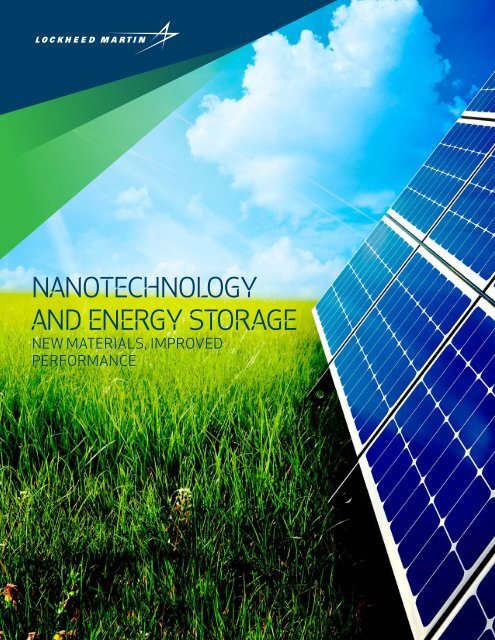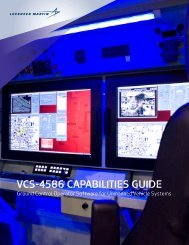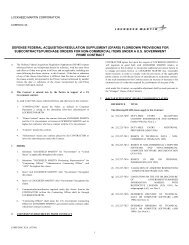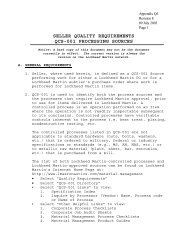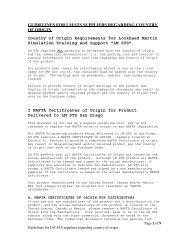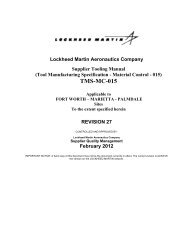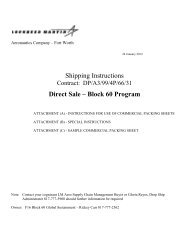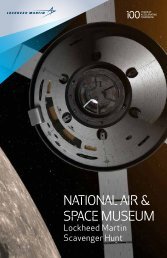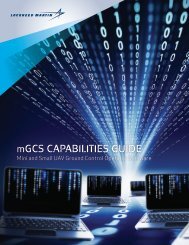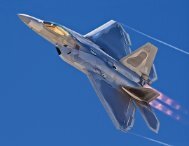NANOTECHNOLOGY AND ENERGY STORAGE - Lockheed Martin
NANOTECHNOLOGY AND ENERGY STORAGE - Lockheed Martin
NANOTECHNOLOGY AND ENERGY STORAGE - Lockheed Martin
- No tags were found...
Create successful ePaper yourself
Turn your PDF publications into a flip-book with our unique Google optimized e-Paper software.
<strong>NANOTECHNOLOGY</strong><strong>AND</strong> <strong>ENERGY</strong> <strong>STORAGE</strong>NEW MATERIALS, IMPROVEDPERFORMANCE
<strong>Lockheed</strong> <strong>Martin</strong>’s Advanced Materials and Nanotechnology research teamsare creating more efficient, environmentally sustainable, and cost-effectivesilicon and carbon nanostructures for novel energy storage solutions. Already,<strong>Lockheed</strong> <strong>Martin</strong> engineers have developed advanced electrode technologiesto enable high-performance lithium-ion batteries, supercapacitors, and flowbatteries designed for use in critical transportation, renewable energy, consumerelectronics, and defense applications.Next Generation Li-Ion Batteries• Lighter weight• Higher energy density• Lower manufacturing costs• High performance at low temperatures• Faster energy transferNext Generation Li-Ion BatteriesThe major drawbacks of today’s carbon anode lithiumionbatteries are two-fold: they have modestlithium-loading capacity that limits the amount ofenergy they store per gram of anode material, and theirperformance suffers as ambient temperature drops.<strong>Lockheed</strong> <strong>Martin</strong> engineers addressed both of theseissues by designing nano-infused electrodes that cantolerate much higher loadings of lithium. And whenmatched with newly designed electrolytes that optimizeelectrode performance and commercially availablecathodes, the batteries retain their performancecharacteristics over a wider range of operationaltemperatures.Test results on the electrodes and batteries built withnanosilicon anodes show superior performance:• Over 300 percent greater capacity compared toexisting carbon anode materials• 70 percent retention of discharge capacity over300 charge/discharge cycles• 80 percent reduction in anode weightThese developments are leading to a 25 percentimprovement in energy density in batteries designedas drop-in replacements for current batteries in a widevariety of applications.Multi-layer PWBs using surface mounttechnology, Rigid-Flex
SupercapacitorsCharacterized by fast charge and dischargecapabilities over hundreds of thousands ofcycles, supercapacitors serve in a wide range ofcommercial power storage applications, includinglight-rail regenerative breaking systems, loadleveling in electric and hybrid electric vehicles, aswell as in utility-scale power grids. Now, innovativetechnology developed by <strong>Lockheed</strong> <strong>Martin</strong>’swholly-owned subsidiary Applied NanoStructuredSolutions, LLC (ANS), is set to enablesupercapacitors with significant improvements inperformance characteristics:250%200% Improvement• Up to 200 percent improvement inspecific capacitance• Three-fold boost in high-rate capability• At least a 15 percent improvement inlow-rate capability• Three- to four-fold enhancement ofthrough-plane conductivityImprovement Over Commerical200%150%100%50%15% ImprovementANS’s new technology can infuse substrates ina continuous, high-volume manner with highlycrosslinked matrices of carbon nanostructures(CNS). The resulting paper-like CNS supercapacitormaterial works in both organic and aqueoussolutions. ANS is now exploring commercialdevelopment with major power system andsupercapacitor manufacturers.Grid Storage: Near Term SolutionWhen it comes to storing hours of power, fewbatteries can match the theoretical performanceof a flow battery system. Though flow batteriesare touted as having performance characteristicsthat are well suited to store electricity produced bywind and solar installations, the high cost of thesebattery systems has limited their adoptionby utilities.0%1 10 100 1000 10000Scan Rate (mV/Sec)terms of energy, coulombic, and voltage efficiency over1,500 charge/discharge cycles, more than double theproject’s target.ANS engineers are now optimizing material selection anddesign of the new electrodes and will continue long-termcycle testing. ANS intends to license this technology tocommercial development partners.ANS has taken a major step toward reducing theexpense of flow battery systems by using itsCNS technology to dramatically lower the cost ofthe cell stacks that charge and discharge storedenergy. While conventional cell stacks cost upwardsof $1,000/kW, ANS’s CNS-infused electrodes –with five times the current density capacity andimproved system-level efficiencies – dramaticallyreduces the stack and system costs. Internal teststo date have demonstrated stable performance in
<strong>Lockheed</strong> <strong>Martin</strong> Corporation6801 Rockledge DriveBethesda, MD 20817www.lockheedmartin.com/nanoCopyright ©2013 <strong>Lockheed</strong> <strong>Martin</strong> CorporationAll rights reservedCET201302009GS9509


